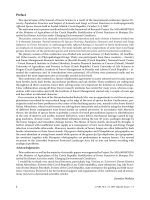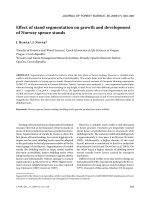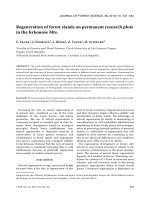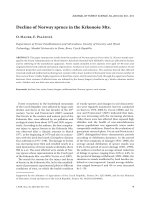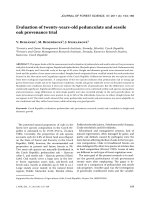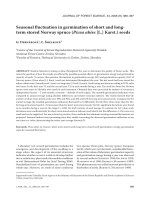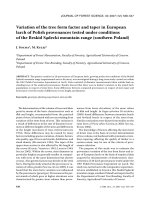Báo cáo lâm nghiệp: "International Symposium “Forest soils under global and local changes” Bordeaux" ppsx
Bạn đang xem bản rút gọn của tài liệu. Xem và tải ngay bản đầy đủ của tài liệu tại đây (29.37 KB, 1 trang )
Ann. For. Sci. 63 (2006) 535–535 535
c
INRA, EDP Sciences, 2006
DOI: 10.1051/forest:2006039
Foreword
International Symposium “Forest soils under global
and local changes”
Bordeaux, 15–18 September 2004
Under the auspices of the International Union of Soil
Sciences (IUSS) and International Union of Forest Research
Organization (IUFRO), 100 scientists representing 20 coun-
tries, 37 universities and 15 research institutes attended in
September 2004 a four-day international symposium “Forest
soils under global and local changes: from research to prac-
tice” in Bordeaux, France. The symposium was co-organized
by IEFC (European Institute of Cultivated Forests), INRA
(National Institute of Agronomic Research) and ENITAB
(National School of Agricultural Engineers of Bordeaux).
There were seven plenary sessions and the papers published
in this issue were presented in three sessions.
– The article on potential for increase in CO2 flux from
forest soils in Japan (Ishizuka et al.) was presented in ses-
sion1onCarbon and Greenhouse Gases. This session pro-
vided an update and deep insights into the issues of C sinks
and fluxes from forest soils. As illustrated by this article, main
items of interest in this session included the spatial and tem-
poral changes due to high variability at the local and regional
scales and the need to combine information from soil surveys
with forest management in the context of the whole system
(soil-climate-forest practices). New attempts of modelling C
fluxes were presented taking into account abiotic (temperature
and moisture) and biotic (vegetation species) factors. Research
results on C pools in forest ecosystems and their spatial and
temporal variation were provided including dynamics of C in
biomass components and in the forest soil. Development of
methodologies for soil respiration and soil CO2 concentrations
measurements were also presented.
– The article on diversity of wood decomposer communities
in different forest stands (Kulhankova et al.) was presented in
session 2 on Soil Biology. Presentations in this session covered
the nature and extent of changes in soil biota and their activity
under future global change scenarios and under land use and
management changes. The role of forest soils as habitat for
diverse organisms and the potential effects of management
and global change on soil function though habitat modifica-
tion were discussed during the session with case studies pre-
sentations. The article illustrates and compares the dynamics
of colonization of similar dead wood sample by decomposer
communities in a native forest and in four single-species forest
plantations.
– The article on Carbon and Nutrient stocks in mature Quer-
cus robur stand in Spain (Balboa et al.) was presented in ses-
sion3onProductivity and Nutrition. Many examples and
posters from various regions of the world were provided dur-
ing that session; they gave insights into nutrient balance, nu-
trient cycling capacity and nutritional constraints from for-
est systems ranging from high-yielding eucalypt plantations
in Brazil where soil texture is an important indicator of soil
quality to pedunculate oak stands and extensive holm oak for-
est areas in Spain which are subjected to severe degradation as
a consequence of poor management and fire damage. The ses-
sion was concluded with a presentation of results from conifer-
ous forest ecosystems subjected to experimental manipulation
involving altered nitrogen deposition, emphasising the need,
in forest research, for projects of longer duration than conven-
tionally programmed by funding agencies.
Other sessions of the symposium included (4) Sustainable
Forest and Soil Management, (5) hydrological cycles, (6),Dis-
turbances and site restoration, and (7) Residues recycling in
forests.
Jean-Michel Carnus
INRA Centre Bordeaux Aquitaine
Article published by EDP Sciences and available at or />
